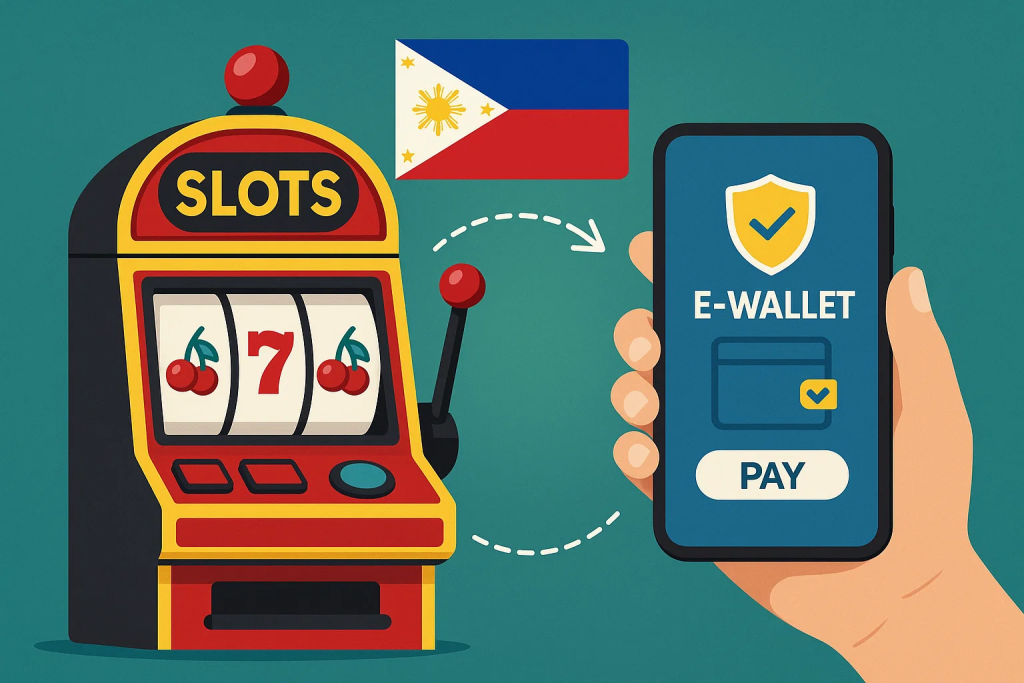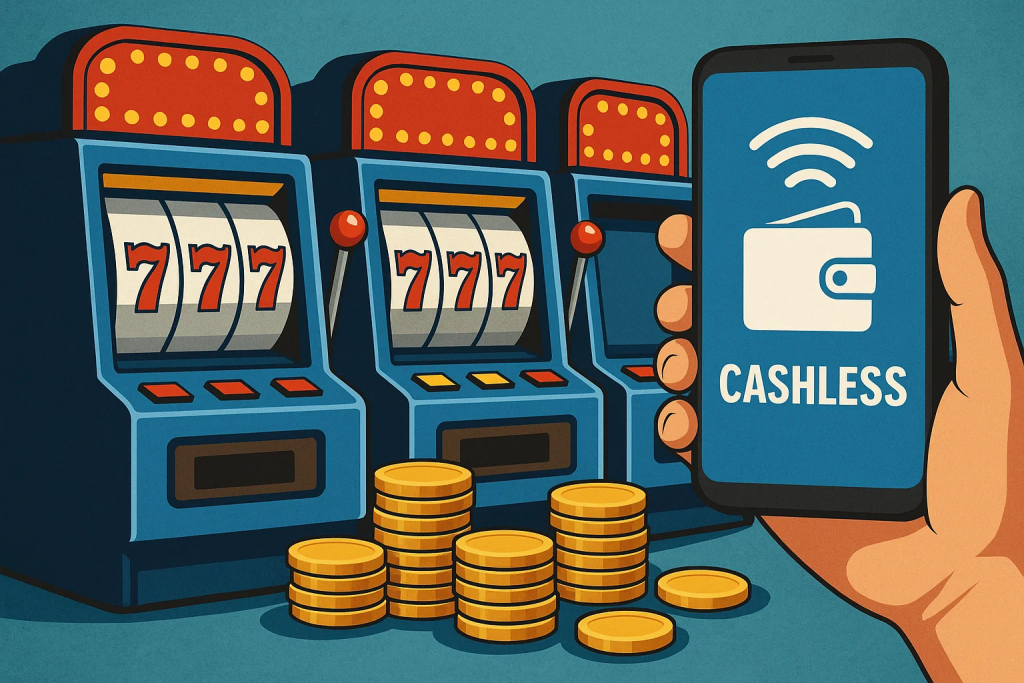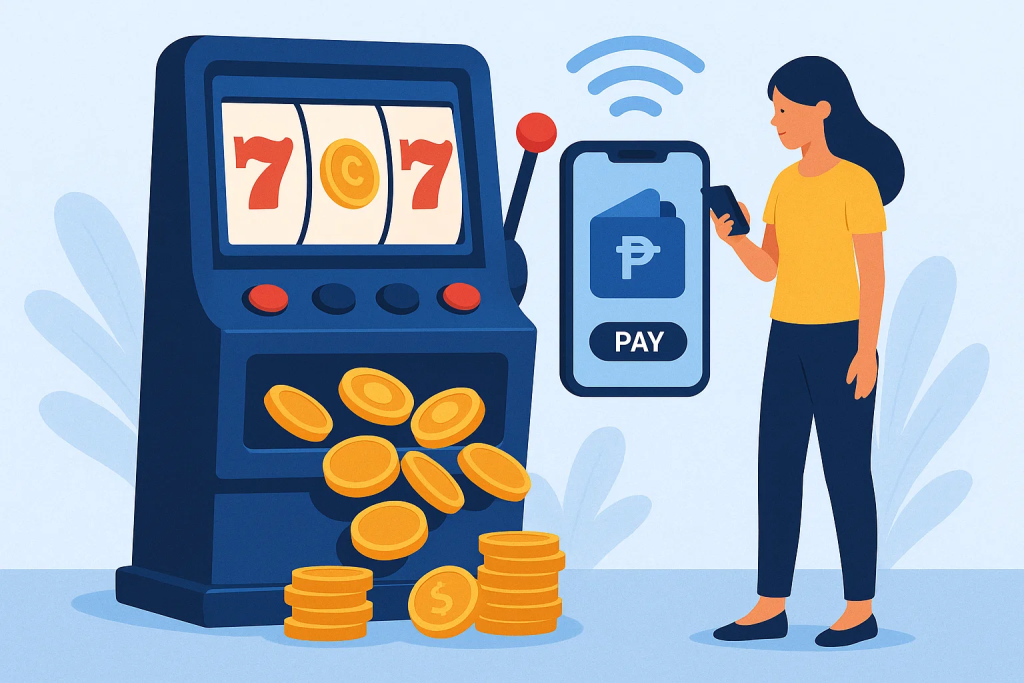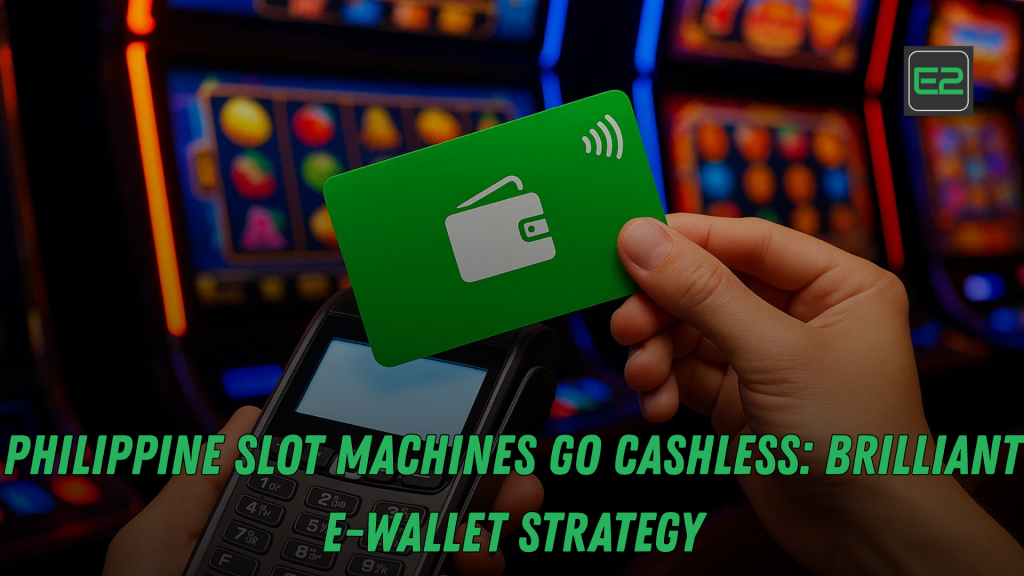Table of Contents
Executive Summary
Cashless slot machines are no longer a “nice to have”—they’re the new baseline for player convenience, operational resilience, and regulatory-grade transparency. In the Philippines, the winning move is to deploy an e-wallet–centric ecosystem that blends seamless QR or NFC payments at slots with robust KYC/AML, built-in responsible gambling controls, and deep loyalty integration.

This guide details a player-first, compliance-forward blueprint: architecture options (TITO vs. account-based), onboarding and eKYC, risk controls, marketing flows, treasury and cage redesign, data analytics, cybersecurity, outage playbooks, and a 90-day rollout plan. We’ll also outline KPIs and a 12-month roadmap so you can deploy, learn, and scale with confidence.
Important: Gambling regulations evolve. Always align implementation with current national and local rules, licensing conditions, and AML/CFT standards. Promote responsible play; offer limits, cooling-off, and self-exclusion tools.
Why Cashless Slots Now? The Four Big Drivers
- Frictionless player experience
- No more queues at the cage or scrambling for small bills.
- Faster session starts, quicker denomination changes, and on-the-fly bankroll top-ups.
- Operational efficiency
- Fewer cash handling errors and armored-car cycles.
- Lower reconciliation overhead; automated logs feed finance and compliance.
- Compliance & transparency
- Digital trails strengthen AML/CFT monitoring and dispute investigation.
- Real-time velocity controls; clearer source-of-funds checks where required.
- Data & loyalty flywheel
- Link every spin to a player profile (with consent), unlocking precision comps, next-best-offer, and lifetime value modeling.
- True omnichannel: connect slots, tables, hotel, F&B, and online touchpoints via one wallet.
The Architecture: Two Paths to Cashless (and When to Use Each)
A) TITO-Plus (Ticket-In, Ticket-Out Enhanced)
- How it works: Keep your TITO backbone; add kiosks or mobile wallet portals that convert e-wallet value into machine-readable credits (tickets or digital tokens).
- Pros:
- Works with legacy floors; modest capital outlay.
- Familiar to ops teams; low training curve.
- Cons:
- Some latency between wallet and machine balance.
- Less granular telemetry than full account-based.
Best for: Properties starting their digital journey, mixed-vintage floors, or limited capex windows.
B) Account-Based Wagering (ABW) with E-Wallet Core
- How it works: Player links an approved e-wallet to their casino account; slots pull/push credits in real time via secure APIs.
- Pros:
- Real-time balance updates; tighter AML controls.
- Best data fidelity; richer loyalty logic and RG tools.
- Cons:
- Heavier integration (SAS/IGT/Aristocrat protocols, CMS, wallet switch).
- Requires rigorous cybersecurity and HA (high availability).
Best for: New or renovated floors, flagship casinos, and brands building a unified omnichannel wallet.
Hybrid reality: Many operators start on TITO-Plus, harden KYC/AML, then graduate to ABW in phases.
Cashless E-Wallet Fundamentals for Philippine Casino Floors
1) Onboarding & eKYC
- Tiered onboarding:
- Tier 0: basic registration with low limits.
- Tier 1–2: ID + liveness + sanctions/PEP screening; higher limits.
- Capture consents (data, marketing, RG notifications) explicitly.
- Support walk-up and host-assisted flows; use QR posters and NFC taps for instant app downloads.
2) Payments Rails & Funding
- Support bank transfers, card top-ups (as permitted), cash-in at kiosks, and over-the-counter partners.
- Offer pre-authorized limits and spending notifications.
- Design rapid reversal for failed funding to minimize service calls.
3) At-Machine UX
- QR/NFC panel on each slot or a seat-side scan marker.
- One-tap connect → confirm denomination → auto-load session bankroll (player-defined).
- Floating wallet visible in the corner overlay (or LED panel) with responsible play meters (daily spend, session time).
4) Cash-out & Breakage
- Partial cash-out to wallet anytime; full cash-out at end of session.
- Offer auto-save of leftover credits to wallet (no lost tickets).
- Clear breakage policy (unclaimed credits) compliant with escheatment rules.
Cashless Compliance by Design (AML/CFT, RG, Privacy)
AML/CFT Controls
- KYC tiers map to transaction thresholds.
- Real-time monitoring: velocity checks, structuring patterns, high-risk flags.
- Case management: alert triage, SAR/STR drafting workflows, audit trails.
- Sanctions/PEP refresh on schedule; device fingerprinting for mule risk.
Responsible Gambling (RG)
- In-app and on-machine deposit, loss, and time limits (hard and soft caps).
- Cooling-off (24–72h) and self-exclusion (property-wide; network-wide if available).
- Nudges: “You’ve reached 90% of your daily limit”; easy opt-down flow.
- Help links to counseling hotlines and RG education.
Data Privacy & Consent
- Purpose-bound data collection; transparent retention windows.
- “Download my data” and “Forget me” controls where applicable.
- Privacy-by-default: minimal PII on device; vault sensitive data centrally.

Treasury, Cage & Floor Ops: Rethinking the Flow
- Cage 2.0: Fewer cash windows, more kiosk assisted cash-in/out.
- Kiosks: Accept cash, dispense QR credits, facilitate ID verification with staff assist.
- Float & reconciliation: End-of-day (EOD) closes wallet switch, CMS, and GL feed; auto-match exceptions for manual review.
- Change management: Train GMs, cage, attendants, hosts, security, and IT on incident trees (e.g., lost device, stuck funds).
Marketing the Cashless Advantage (Without Promoting Harm)
- Value props: Faster play, safer funds, instant comps, and contactless hygiene.
- Launch packs: Free wallet credit with responsible-play disclaimer; double loyalty points on first week with limits.
- Host toolkit: QR lanyards, one-minute demos, “limit setting” as a VIP service.
- Cross-property: Wallet works at hotel, F&B, shows—unlock earn & burn everywhere.
Analytics: Turning Cashless Spins into Strategy
- Session intelligence: Time-on-device, denom shifts, volatility tolerance, stop reasons.
- RG dashboards: Limit adherence, nudges acknowledged, cool-off uptake.
- Loyalty science: Propensity models for next-best-offer (free play vs. F&B vs. rooms).
- Ops insights: Queue heatmaps at kiosks, breakage rates, exception patterns.
- Fraud analytics: Unusual device clusters, rapid cash-in/cash-out loops, multi-account behaviors.
Cashless Cybersecurity & Platform Resilience
- Zero-trust network segmentation; MFA for staff consoles; HSM for keys.
- API gateways with rate limits; WAF + bot mitigation; signed payloads.
- HA & DR: Active-active wallet switch, data replication, runbooks for partial floor outages.
- Incident playbooks: Payment degraded, kiosk offline, sanctions false positive, PII exposure drill.
- Third-party risk: Annual pen tests, SOC2/ISO reports from vendors, SBOM for critical components.
Cashless Outage & Contingency Scenarios (and How to Respond)
- Wallet switch downtime
- Fallback to TITO where possible; display “cashless temporarily unavailable” on machine panels.
- SMS/app push to players; enable grace cash-out at kiosks.
- Kiosk cash acceptor failure
- Redirect to nearby kiosk; ops chat updates every 15 minutes; dispatch field techs.
- Sanctions false positive
- Manual review queue; 24-hour resolution SLA; empathetic messaging and credit hold explanation.
- Device loss
- Instant wallet freeze + recovery verification; optional remote logout of all sessions.
Rollout: The 90-Day Playbook
Days 1–30: Foundations
- Choose TITO-Plus vs. ABW (or hybrid).
- Vendor due diligence; sign data processing agreements.
- Draft policy stack: KYC tiers, AML scenarios, RG limits, privacy.
- Map integrations: wallet switch ↔ CMS ↔ slot protocols ↔ kiosks ↔ GL.
- Staff champions: appoint cashless captain per shift.
Days 31–60: Pilot
- Equip one zone (30–50 machines) with QR/NFC panels.
- Soft-launch to loyalty tiers; collect NPS, drop/handle per machine, time-to-fund metrics.
- Run RG A/B test on limit prompts and language.
- Tabletop incident drills (wallet freeze, kiosk jam, partial outage).
Days 61–90: Scale & Market
- Expand to 30–50% of floor; turn on earn & burn across F&B.
- Public launch: tutorials on screens; hosts demo stations.
- Weekly KPI reviews; incremental optimizations (UI text, kiosk placement, funding options).
KPIs That Matter
- Adoption: % of active slot players using e-wallet; first-time wallet conversions.
- Time-to-fund: Median seconds from scan to credits loaded.
- RG engagement: % with limits set; cool-off/self-exclusion activations (monitored with care).
- Ops: Kiosk queue wait times; exception rate per 1,000 transactions; EOD reconciliation delta.
- Revenue quality: Handle/day from cashless vs. cash cohorts; comp efficiency; F&B uplift from wallet spend.
- Risk: AML alert rate, false positive rate, average case closure time; fraud loss as % of handle.
- CSAT/NPS: Wallet app rating; on-floor satisfaction surveys.
12-Month Roadmap (Scale with Discipline)
- Q1: Pilot + staff training; publish RG policy; first dashboard set.
- Q2: 50–70% floor coverage; launch earn & burn; introduce tiered KYC fully.
- Q3: Move toward account-based wagering on premium banks; integrate hotel PMS.
- Q4: Full-floor coverage; unify online/offline wallet where permitted; advanced analytics (LTV, churn, cross-sell); annual security audit.
Myths vs. Facts
- Myth: “Cashless will kill tips and comps.”
Fact: Digital tips and instant comps can increase redemption; it’s UX design, not destiny. - Myth: “Older players won’t adopt.”
Fact: Guided host onboarding and simple QR flows deliver strong senior adoption, especially when linked to reliable payouts and no lost tickets. - Myth: “Cashless equals more problem gambling.”
Fact: Proper limits, cooling-off, and nudges make cashless safer than cash—because you can measure and manage.
Ethical Guardrails & Community Trust
- Prominently display responsible gaming tools and support hotlines.
- Offer budgeting education content in-app.
- Collaborate with local stakeholders (tourism, LGUs, community groups) to address concerns and share safeguards transparently.
Call to Action
If you’re a casino executive or product lead, the window to lead is now. Start with a pilot zone, harden KYC/AML/RG, and make the e-wallet the heart of your guest journey—from lobby to slots to supper. With the right UX, controls, and culture, cashless isn’t just a payment method; it’s your competitive moat.
Want a tailored pilot blueprint (floor map, kiosk placement, KPI deck, and training scripts)? Share your floor size, slot mix, and current CMS—we’ll draft a pilot plan you can execute in 90 days.
Final Words
The article lays out a practical, compliance-forward roadmap for Philippine casinos to implement cashless slot machines centered on e-wallets. It argues cashless is now a competitive baseline—improving player experience, operational efficiency, transparency for AML/CFT, and data-driven loyalty—and shows how to deploy it without compromising responsible gambling or resilience.
Why cashless now
Four forces drive adoption: (1) Frictionless UX—no cage queues, faster session starts, instant top-ups; (2) Operational efficiency—less cash handling, fewer reconciliation errors; (3) Compliance—digital trails enable real-time monitoring, source-of-funds checks, and clean audits; (4) Data & loyalty—linking spins to profiles powers precision comps, omnichannel rewards, and lifetime value models.
Two architectures
- TITO-Plus (Ticket-In, Ticket-Out enhanced): Keep legacy TITO, add kiosks/app flows to convert e-wallet value into machine credit. Pros: lower capex, familiar ops. Cons: less telemetry, latency between wallet and machine. Best for mixed-vintage floors and starters.
- Account-Based Wagering (ABW) with e-wallet core: Real-time balance push/pull via APIs between wallet, CMS, and slot. Pros: best data, tighter AML, instant UX. Cons: heavier integration and cybersecurity demands. Best for flagship or renovated floors. Many operators start on TITO-Plus, then phase toward ABW.

E-wallet fundamentals
Onboarding/eKYC: Tiered KYC (low-limit Tier 0 → fully verified high-limit Tiers 1–2) with ID, liveness, sanctions/PEP screens, and explicit consent capture. Support walk-up and host-assisted signups.
Funding rails: Bank transfers, permitted cards, cash-in kiosks, OTC partners; provide pre-authorized limits, notifications, and easy failure reversals.
At-machine UX: QR/NFC panel; one-tap connect; confirm denomination; auto-load a player-defined bankroll. Show floating wallet + responsible-play meters (time and spend).
Cash-out & breakage: Partial or full cash-out anytime to wallet; auto-save leftover credits; clear breakage/escheat policy.
Compliance by design
AML/CFT: Map KYC tiers to thresholds, add real-time velocity/structuring checks, case management for alerts, scheduled sanctions refresh, and device fingerprinting to deter mules.
Responsible Gambling (RG): In-app/on-machine deposit, loss, and time limits (soft/hard caps), cooling-off, self-exclusion, threshold nudges, and hotline links.
Privacy: Purpose-bound data, transparent retention, “download/forget me” options, and privacy-by-default—minimal PII on devices, vaulted centrally.
Treasury & floor operations
Recast the cage as a hybrid service point: fewer cash windows, more kiosk-assisted flows and ID verify. Kiosks handle cash-in/out and QR crediting. EOD reconciles wallet switch, CMS, and general ledger with auto-match exceptions. Train every role (GMs, cage, attendants, hosts, security, IT) on incident trees for stuck funds, lost devices, or sanctions holds.
Marketing (without promoting harm)
Lead with convenience and safety: faster play, no lost tickets, instant comps, contactless hygiene. Use launch packs (modest free credits with RG disclaimers), double points for week one (with limits), and host demo stations. Extend wallet earn & burn to hotel, F&B, and shows to make the wallet the guest’s universal tender.
Analytics to steer the program
Track session intelligence (time-on-device, denom shifts, stop reasons), RG dashboards (limit uptake, cool-offs), loyalty science (next-best-offer models), ops insights (kiosk queues, breakage), and fraud (rapid cash-in/out loops, device clusters). Use findings to refine UI, machine banks, and offer design.
Cybersecurity & resilience
Adopt zero-trust segmentation, MFA for consoles, HSM-managed keys, API gateways with rate limits, WAF/bot mitigation, and signed payloads. Build high availability (active-active wallet switch, replicated data) and runbooks for partial outages. Vet vendors (SOC2/ISO, pen tests, SBOM). Tabletop drills sharpen staff responses.
Outage playbooks
- Wallet downtime: Fall back to TITO; message on panels and via app; enable grace cash-outs.
- Kiosk failure: Redirect, update ops chat every 15 minutes; dispatch techs.
- Sanctions false positive: Manual review with a 24-hour SLA and empathetic messaging.
- Lost device: Instant wallet freeze, identity re-verification, remote logout.
90-day rollout plan
Days 1–30: Choose TITO-Plus vs. ABW (or hybrid); complete vendor due diligence and data-processing agreements; publish KYC/AML/RG/privacy policies; map integrations; appoint cashless captains.
Days 31–60: Pilot 30–50 machines with QR/NFC; soft-launch to loyalty members; measure adoption, time-to-fund, exceptions; A/B test RG prompts; run incident drills.
Days 61–90: Scale to 30–50% of floor; enable earn & burn across F&B; run tutorials and host demos; hold weekly KPI reviews and optimize kiosk placement, UI text, and funding options.
KPIs that matter
Adoption rate, time-to-fund, RG engagement (limits/cool-offs), kiosk queue times, reconciliation deltas, AML alert/false-positive rates, case closure time, fraud losses, handle/day by cohort, comp efficiency, F&B wallet uplift, and CSAT/NPS.
12-month roadmap
Q1: Pilot, staff training, RG policy, first dashboards.
Q2: 50–70% floor coverage, full tiered KYC, earn & burn.
Q3: ABW on premium banks, hotel PMS integration.
Q4: Full floor, unify online/offline wallet where allowed, advanced analytics (LTV/churn/cross-sell), annual security audit.
Myths vs facts
Digital tips/comps can rise with better UX; seniors adopt when guided; cashless with limits and cooling-off is often safer than cash because it’s measurable and controllable.
Ethics & trust
Highlight RG tools, offer budgeting education in-app, and collaborate with LGUs and community groups to explain safeguards. Transparency builds legitimacy.
Call to action
Appoint a health-compliant cashless champion, publish a one-page policy stack, pilot a zone within 90 days, and make the e-wallet the heart of the guest journey across slots, rooms, and dining. With the right UX, controls, and culture, cashless becomes more than a payment method—it’s a competitive moat for Philippine casinos.
Frequently Asked Questions (FAQ)
1) What’s the fastest way to start if our slot floor is mixed-vintage?
Begin with TITO-Plus on a pilot bank using QR panels and kiosks. Keep the CMS integration light, measure adoption, time-to-fund, RG uptake, and exception rates, then iterate before moving to account-based wagering on newer machines.
2) How do we balance AML/CFT with a smooth player experience?
Use tiered eKYC: low-limit access for basic users; higher limits for fully verified players. Run real-time monitoring in the background (velocity, structuring flags) and keep case handling empathetic with clear communication.
3) What responsible gambling tools are essential on Day 1?
Implement deposit/loss/time limits, cooling-off, self-exclusion, and nudges at threshold points. Make limits easy to set, easy to review, and hard to override without a waiting period.
4) How do we measure success beyond handle growth?
Track wallet adoption, time-to-fund, RG engagement, kiosk queue times, reconciliation deltas, AML false positives, and CSAT/NPS. Watch F&B uplift via earn & burn and comp redemption efficiency.
5) We worry about downtime. What’s the redundancy plan?
Design for high availability (active-active wallet switch), keep a TITO fallback, and maintain incident playbooks (comms templates, escalation trees). Test quarterly with tabletop drills to ensure staff muscle memory.
